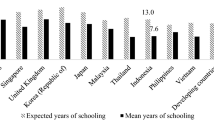Abstract
Theories of human interactions suggest population growth is influenced by the extent of knowledge. Examining the population (and employment) growth rates of all 254 Texas counties over the 1990–2000 and 1980–1990 decades as dependent variables, the share of population with college degree or higher has a greater impact on growth more recently. The instrumental variables treatment of human capital with age and race characteristics leads to differences at the top end of education explaining population growth across Texas. These results are very robust to several control variables including demographic, migration, and regional factors.
Similar content being viewed by others
References
Andersson M, Lööf H (2010) Agglomeration and productivity: evidence from firm-level data. Ann Reg Sci (forthcoming)
Andersson M (2004) Studies of knowledge, location and growth. Jönköping International Business School (JIBS), Jönköping University. Available at: http://hj.diva-portal.org/smash/record.jsf?searchId=1&pid=diva2:4748
Canton E, de Jong F (2005) The demand for higher education in the Netherlands, 1950–1999. Econ Educ Rev 24: 651–663
Ciccone A, Peri G (2006) Identifying human capital externalities: theory and applications. Rev Econ Stud 73(2): 381–412
Dahl GB (2002) Mobility and the return to education: testing a roy model with multiple markets. Econometrica 70(6): 2367–2420
Glaeser E, Saiz A (2003) The rise of the skilled city, Harvard University, manuscript
Glaeser E (1999) Learning in cities. J Urban Econ 46: 254–277
Glaeser E, Scheinkman J, Schleifer A (1995) Economic growth in a cross-section of cities. J Monet Econ 36: 117–143
Hall R, Jones C (1999) Why do some countries produce so much more output per worker than others. Q J Econ 114: 83–116
Jovanovic B, Rob R (1989) The growth and diffusion of knowledge. Rev Econ Stat 56: 569–582
Karlsson C, Gråsjö U, Andersson M (2006) Regional knowledge accessibility and regional economic growth. CESIS Electronic Working Paper Series Paper No. 66. Available at: http://www.infra.kth.se/cesis/documents/WP66.pdf
Moretti E (2004) Estimating the social return to higher education: evidence from longitudinal and repeated cross-sectional data. J Econom 121: 175–212
Rappaport J (2008) Consumption amenities and city population density. Reg Sci Urban Econ 38: 533–552
Rauch J (1993) Productivity gains from geographic concentration of human capital: evidence from the cities. J Urban Econ 34: 380–400
Simon C, Nardinelli C (2002) Human capital and the rise of American cities, 1900–1990. Reg Sci Urban Econ 32: 59–96
Texas Higher Education Coordinating Board (2006) Closing the Gaps: The Texas Higher Education Plan
Texas Parks and Wildlife Department (2006) Natural Regions of Texas. Available at: http://www.tpwd.state.tx.us/publications/pwdpubs/media/pwd_mp_e0100_1070t_08.pdf
Welch F (2000) Growth in women’s relative wages and in inequality among men: one phenomenon or two. Am Econ Rev AEA Papers Proc 90: 444–449
Wheeler C (2003) Evidence on agglomeration economies, diseconomies, and growth. J Appl Econom 18: 79–104
Author information
Authors and Affiliations
Corresponding author
Rights and permissions
About this article
Cite this article
Mollick, A.V., Mora, M.T. The impact of higher education on Texas population and employment growth. Ann Reg Sci 48, 135–149 (2012). https://doi.org/10.1007/s00168-010-0386-4
Received:
Accepted:
Published:
Issue Date:
DOI: https://doi.org/10.1007/s00168-010-0386-4




